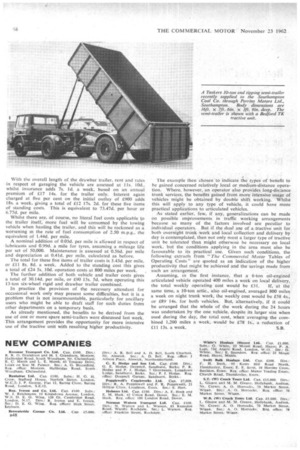With the overall length of the drawbar trailer, rent and
Page 70

If you've noticed an error in this article please click here to report it so we can fix it.
rates in respect of garaging the vehicle are assessed at 115. 10d., whilst insurance adds 7s. Id. a week, based on an annual premium of £17 14s. for the trailer only. Interest again charged at five per cent on the initial outlay of £900 adds 18s. a week, giving a total of £12 17s. 2d, for these five items of standing costs. This is equivalent to 73.47d. per hour or 6.77d. per mile.
Whilst there are, of course, no literal fuel costs applicable to the trailer itself, more fuel will be consumed by the towing vehicle when hauling the trailer, and this will be reckoned as a worsening in the rate of fuel consumption of 2.50 m.p.g., the equivalent of 1.44d, per mile.
A nominal addition of 0.03d. per mile is allowed in respect of lubricants and 0.99d. a mile for tyres, assuming a mileage life per set of 50,000. Maintenance is assessed at 0.56d. per mile and depreciation at 0.41d. per mile, calculated as before.
The total for these five items of trailer costs is 3.43d. per mile, or £11 8s. 8d. a week. Added to the standing cost this gives a total of £24 5s.. 10d. operation costs at 800 miles per week. .
The further addition of both vehicle and trailer costs gives a total of 30.14d. per mile, or £90 15s. 5d. when operating this 13-ton six-wheel rigid and drawbar trailer combined.
In practice the provision of the necessary attendant for occasional work only may present some difficulties, but it is a problem that is not insurmountable, particularly for ancillary users who might be able to draft staff for such duties from other departments on a temporary basis.
As already mentioned, the benefits to be derived from the use of one or more spare semi-trailers were discussed last week. This arrangement provides the opportunity for more intensive use of the tractive unit with resulting higher productivity. The example then chosen to indicate the types of benefit to be gained concerned relatively local or medium-distance operation. Where, however, an operator also provides long-distance trunk services, the benefits gained from more intensive usage of vehicles might be obtained by double shift working. Whilst this will apply to any type of vehicle, it could have more practical applications to articulated vehicles.
As stated earlier, few, if any, generalizations can be made on possible improvements in traffic working arrangements because so many of the factors involved are peculiar to individual operators. But if the dual use of a tractive. unit for both overnight trunk work and local collection and delivery by day is contemplated, then not only must a larger type of tractive unit he tolerated than might otherwise be necessary on local work. but the conditions applying in the area must also be favourable to its practical use. Given such conditions, the following extracts from The Commercial Motor Tables of Operating Costs" are quoted as an indication of the higher productivity that might be achieved and the savings made from such an arrangement.
Assuming, in the first instance, that a 6-ton oil-engined articulated vehicle operated 400 miles a week on local delivery,
the total weekly operating cost would be £31. If, at the same time, a 10-ton artic., also oil-engined, averaged 800 miles a week on night trunk work, the weekly cost would be £58 4s., or £89 14s. for both vehicles. But, alternatively, if it could be arranged that the whole of the work during the 24 hours was undertaken by the one vehicle, despite its larger size when used during the day, the total cost, when-averaging the combined 1,200 miles a week,would. be £78 Is., a reduction of
£11 13s. a week. S.B.








































































































